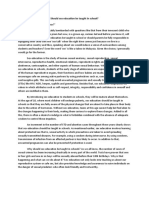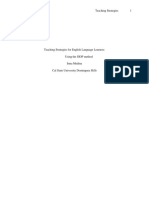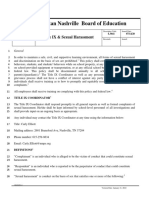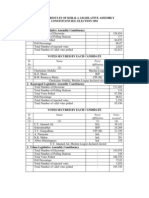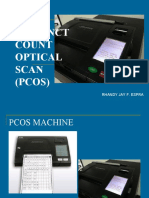Checkers Speech Analysis Portfolio
Checkers Speech Analysis Portfolio
Uploaded by
Michelle RaeCopyright:
Available Formats
Checkers Speech Analysis Portfolio
Checkers Speech Analysis Portfolio
Uploaded by
Michelle RaeOriginal Description:
Copyright
Available Formats
Share this document
Did you find this document useful?
Is this content inappropriate?
Copyright:
Available Formats
Checkers Speech Analysis Portfolio
Checkers Speech Analysis Portfolio
Uploaded by
Michelle RaeCopyright:
Available Formats
Bruni 1 Reconstructing An Image With Ethos As the Presidential debates continue and the Election of 2012 approaches, some
critics ponder whether or not Governor and Presidential candidate Mitt Romney intends on presenting a Checkers speech in order to sympathize with middle class voters. The concept of a Checkers speech dates back to the 1952 Presidential election, when California Senator Richard Nixon addressed over 60 million Americans on national television regarding presumed illegally obtained funds. Nixons Southern California campaign treasurer Dana Smith referred to donations for his future 1956 election campaign as the Fund. Such fund was used to reimburse Nixons travel expenses, which were used to rally support and give speeches across the country, as well as postages for political mailings. The famous speech focused on dismissing rumors that Nixon traded favors for monetary contributions. Although he used personal experiences to portray himself as a commoner, the hook of his argument invokes emotions from his audience as he mentions his dog Checkers. President Nixon refutes the rumors of an alleged fund by attempting to restore his image as a Vice Presidency candidate, as well as making emotional and cogent claims to his audience. The logistics behind Senator Nixons speech are to negate the argument that his funds were handled illegally, and then reconstruct his own argument as to why he is correct. Nixon uses the methods of refutation then reconstruction to conclude that he remains a viable running mate along General Dwight Eisenhower. He states in his opening paragraph that he intends not to do the usual political thing and ignore or deny charges brought against him, but instead tell the truth. Here, Nixon lays the basis for the rest of his speech, meaning he plans on telling the truth throughout his argument. By going into detail about the rumors of the illegal fund, this showcases Nixons first
Bruni 2 attempt at rebuttal. He first acknowledges that handling campaign money secretively would be illegal; he then dismisses allegations of him doing such actions by saying that none of the campaign money was for personal use. This demonstration of ethos contributes to Nixons argument because he does not ignore the subject matter, rather he address it first hand. He then contests that the purpose of the fund was to defray expenses from the Government. Finally, Nixon states that the fund was established so that taxpayers would not have to pay extra for his own campaigning agenda, such as the costs of printing paper for his speeches and trips to make political speeches. The purpose of his opening confutation was to prove that the allegations were incorrect and give substantial proof as to how they were incorrect. To continue with additional evidence, Nixon brings forth a legal audit provided by lawyers. The audit states, Senator Nixon did not obtain any financial gain from the collection of the fund. He chooses to bring outside, independent opinion because he wants the American people to know all the facts. Once again, Nixon reinforces the idea that his argument is correct and that he has nothing to hide. As he continues to explain his reasoning, he gains more credibility. One of the more prominent aspects of his Checkers Speech is the depth into which he explains his financial history. This is important in reestablishing his image, as doing so is unprecedented in the history of American politics. First, Nixon explains growing up in a modest family; he and all of his brothers worked in the family grocery store for most of their early lives. He also mentions he worked his way through college. These two statements are pertinent, as Nixon attempts to relate to the middle class America. They also evoke a sense of ethos and pathos, as he establishes that he worked throughout his life and things were not handed to him, a concept to which middle class citizens can relate. Next, Nixon indicates that
Bruni 3 after his wifes four jobs and his two jobs, their savings consist of under $10,000. All of their savings, incidentally, were all in Government bonds. He also mentions other savings, such as money from speaking engagements and some money inherited from family. All in all, the fact that his savings were miniscule clarifies that he and his wife worked for their savings and did not touch any campaign contributions. Another important part of his financial history is the assertion that he lives modestly. Nixon owns an outdated Oldsmobile and his wife does not own a fur coat. He has about $4,000 in life insurance for himself, but none for his wife and two children. He also does not have any bonds or interest in any businesses. Each of these claims strengthens his image of a common citizen, an idea to which the voting population can also relate. The fact that Nixon openly discusses his financial history is significant to reconstructing the way American citizens view him. He gives them an in-depth look at his personal life in order to shut down charges that could potentially harm his running mate Eisenhower and himself in the 1952 election. Although putting down his opponent does not strengthen his own image, their faults magnify the purpose of Nixons address to the American people. Nixon attacks his opposing Vice Presidency candidate John Sparkman by questioning his openness and honestly with the nation. He state, [they] should come before the American people as I have and make a complete financial statement as to their financial history. And if they dont, it will be an admission that they have something to hide. It is as if Nixon wants the American audience to question the Democratic opposition because they have not come and spoken openly about their finances and campaign contributions. This is a strong closing point for Nixon because it highlights that his actions are wholesome and that citizens do not have to be skeptical of his
Bruni 4 intentions any longer. Nixon concludes his argument by saying, I continued the fight because I know I was right. The logos of this statement suggest that Nixon indeed made his refutation and successfully reconstructed his argument to win over the audience. Although much of Nixons financial situations can have an emotional correlation with the audience, the reference to his dog Checker towards the end of his speech completes his argument that he is like a middle class citizen. Nixon states that he has never accepted personal contributions except his dog Checker. Although Checker is not a monetary gift that would aid Nixon in his next election, his decision to keep the dog is important in recreating his impression. He knows that if he mentions his dog, a mans best friend, in his speech, the audience will develop a new perspective on his values, viewing him as a respected man. The integration of the emotional appeal of his dog successfully changes the publics opinion of him. To conclude, with the help of emotional and logical appeals, Nixon successfully creates a positive image of himself by refuting previous accusations. He does so by straightforward honestly, frankness of his personal matters and direct suggestions to his opponent. As Nixon successfully did so, a Checkers Speech conjures emotions from the audience, thus allowing a change in opinion or image to occur. Although Governor Romney has yet to mention a dog in his speeches, the Checkers method would allow him to connect to the middle class America on an emotional and credible level.
You might also like
- Rhetorical AnalysisDocument3 pagesRhetorical Analysisapi-495077384100% (2)
- Its Not A StorkDocument10 pagesIts Not A Storkapi-539287303No ratings yet
- Raft Unit RationaleDocument5 pagesRaft Unit Rationaleapi-253091638No ratings yet
- Hoffmann2018 Article TheElusiveNotionOfArgumentQualDocument28 pagesHoffmann2018 Article TheElusiveNotionOfArgumentQualIsabelNo ratings yet
- Part II Getting A Job Ubd Lesson PlanDocument3 pagesPart II Getting A Job Ubd Lesson Planapi-336180144100% (1)
- Rogerian ArgumentDocument8 pagesRogerian Argumentapi-232536315100% (1)
- Final Annotated BibliographyDocument5 pagesFinal Annotated BibliographyEmily Gorham100% (1)
- Nal Lesson PlanDocument2 pagesNal Lesson Planapi-409777377No ratings yet
- Painful Lessons EnglishDocument92 pagesPainful Lessons EnglishNestor BalboaNo ratings yet
- Rhetorical AnalysisDocument10 pagesRhetorical Analysisapi-388480954No ratings yet
- Rhetorical Analysis EssayDocument5 pagesRhetorical Analysis Essayapi-302399796No ratings yet
- Rhetorical Analyis Essay Final DraftDocument7 pagesRhetorical Analyis Essay Final Draftapi-316347140No ratings yet
- Letter To LegistlatorDocument8 pagesLetter To Legistlatorapi-533834366No ratings yet
- Unit I Critical Analysis of Annual ReportDocument5 pagesUnit I Critical Analysis of Annual Reportapi-478665205No ratings yet
- Sample Speaking OutlineDocument2 pagesSample Speaking OutlineAtiqah NadirahNo ratings yet
- UBD Stage 2 - Acceptable EvidenceDocument12 pagesUBD Stage 2 - Acceptable Evidencedebra_scott_6No ratings yet
- Educational Equity For English Language LearnersDocument28 pagesEducational Equity For English Language Learnersapi-269928551No ratings yet
- Unit Plan Reflection On Teaching and LearningDocument2 pagesUnit Plan Reflection On Teaching and LearningAnonymous Z9zcD6BzNo ratings yet
- Resume ChecklistDocument3 pagesResume ChecklistkriswerdNo ratings yet
- The Colin Kaepernick Act of Resistance: Get Up! Stand Up and Take A KneeDocument10 pagesThe Colin Kaepernick Act of Resistance: Get Up! Stand Up and Take A KneeDelroy SimmsNo ratings yet
- Rhetorical EssayDocument7 pagesRhetorical Essaycmtodd13No ratings yet
- Rape As A Social ProblemDocument11 pagesRape As A Social ProblemOladipo Chukwudi OluwaseunNo ratings yet
- Ubd Lesson Plan - AssessmentDocument2 pagesUbd Lesson Plan - Assessmentapi-242935457No ratings yet
- Annotated BibliographyDocument7 pagesAnnotated Bibliographyapi-3023446810% (1)
- Final Irr Ap Seminar - Political and Historical of School ShootingsDocument8 pagesFinal Irr Ap Seminar - Political and Historical of School Shootingsapi-610394461No ratings yet
- Chappaquiddick Address - EditedDocument8 pagesChappaquiddick Address - Editedapi-510429855No ratings yet
- New American Lecture Lesson Plan1Document3 pagesNew American Lecture Lesson Plan1api-231354055No ratings yet
- Should Sex Education Be Taught in SchoolDocument2 pagesShould Sex Education Be Taught in SchoolbuttonmushroomsNo ratings yet
- Kevin Speers 6 Week Group Lesson Plan Career ReadinessDocument13 pagesKevin Speers 6 Week Group Lesson Plan Career Readinessapi-459424184No ratings yet
- Argument of Policy EssayDocument6 pagesArgument of Policy Essayapi-613940927No ratings yet
- UBD Lesson - Who Are The PoorDocument1 pageUBD Lesson - Who Are The PoorksurpNo ratings yet
- 10 Rhetorical Devices Used in Political MessagesDocument2 pages10 Rhetorical Devices Used in Political MessagesThistleNo ratings yet
- Understanding by Design Unit With Learning ExperiencesDocument16 pagesUnderstanding by Design Unit With Learning ExperiencesBarry FeldmanNo ratings yet
- False ScarcityDocument12 pagesFalse ScarcityErek SlaterNo ratings yet
- Sex EdDocument18 pagesSex Edjoeriz jillNo ratings yet
- Immigrant InterviewDocument6 pagesImmigrant Interviewapi-516586218No ratings yet
- Action Research Paper Final 2Document63 pagesAction Research Paper Final 2api-427114924No ratings yet
- Rogerian Argument EssayDocument6 pagesRogerian Argument Essayapi-549201461100% (1)
- Credibility and Dependability in Qualitative Case Study MethodDocument3 pagesCredibility and Dependability in Qualitative Case Study MethodmarshadriceNo ratings yet
- ParsonsfinalDocument15 pagesParsonsfinalapi-455782221No ratings yet
- Wealth and Poverty Research PaperDocument9 pagesWealth and Poverty Research Paperapi-461706989No ratings yet
- Colin KaepernickDocument2 pagesColin Kaepernickapi-533580064No ratings yet
- Lbs 303-Research Paper FinalDocument9 pagesLbs 303-Research Paper Finalapi-403088205No ratings yet
- Police BrutalityDocument13 pagesPolice Brutalityapi-466414033No ratings yet
- Developing An Early Warning System: Identifying Factors That May Predict High School Completion by 6th Grade StudentsDocument32 pagesDeveloping An Early Warning System: Identifying Factors That May Predict High School Completion by 6th Grade StudentsJacksonville Public Education FundNo ratings yet
- Annotated BibliographyDocument5 pagesAnnotated Bibliographyapi-302842071No ratings yet
- Culturally Responsive School LeadershipDocument8 pagesCulturally Responsive School Leadershipapi-326382783No ratings yet
- Argumentative Essay: CensorshipDocument7 pagesArgumentative Essay: Censorshipapi-350323599No ratings yet
- Ethnography ESSAYDocument10 pagesEthnography ESSAYMalika TamimNo ratings yet
- Chapter1-2 - Impact of Black Teachers On Black Student's AchievementsDocument13 pagesChapter1-2 - Impact of Black Teachers On Black Student's AchievementsLoisNo ratings yet
- MNPS Title IX and Sexual Harassment PolicyDocument6 pagesMNPS Title IX and Sexual Harassment PolicyUSA TODAY NetworkNo ratings yet
- Ethnographic EssayDocument5 pagesEthnographic Essayapi-253251530No ratings yet
- Recycling Research PaperDocument10 pagesRecycling Research PaperGabe GuralnickNo ratings yet
- Precious Knowledge A Critical AnalysisDocument5 pagesPrecious Knowledge A Critical Analysisapi-491294996No ratings yet
- Gerona Scholarly Reflection 2Document9 pagesGerona Scholarly Reflection 2api-544562008No ratings yet
- Financing Schools: Analysis and RecommendationsDocument20 pagesFinancing Schools: Analysis and RecommendationsAmjad IbrahimNo ratings yet
- Rhetorical AnalysisDocument3 pagesRhetorical AnalysisKunal GoyalNo ratings yet
- Breaking The Silence LGBTQ Students FinalDocument7 pagesBreaking The Silence LGBTQ Students Finalapi-286434558No ratings yet
- Modern Violence and Weapons in Schools: (Awareness of Dangers in Schools Lesson To: Students, Parent, School Owners, and the Government)From EverandModern Violence and Weapons in Schools: (Awareness of Dangers in Schools Lesson To: Students, Parent, School Owners, and the Government)No ratings yet
- 20 - B - Case Study - CaloocanDocument8 pages20 - B - Case Study - CaloocanJC ManantanNo ratings yet
- Leyte, LeyteDocument2 pagesLeyte, LeyteSunStar Philippine NewsNo ratings yet
- Abella V ComelecDocument2 pagesAbella V ComelecAnonymous oDPxEkdNo ratings yet
- Patrick Poll: Support For Privacy Legislation Remains StrongDocument2 pagesPatrick Poll: Support For Privacy Legislation Remains StrongDanPatrickTXNo ratings yet
- Certified List of Candidates For Congressional and Provincial Positions For The May 13, 2013 2013 National, Local and Armm ElectionsDocument2 pagesCertified List of Candidates For Congressional and Provincial Positions For The May 13, 2013 2013 National, Local and Armm ElectionsSunStar Philippine NewsNo ratings yet
- Wallstreetjournaleurope 20170613 The Wall Street Journal EuropeDocument20 pagesWallstreetjournaleurope 20170613 The Wall Street Journal EuropeanthonycacciolaNo ratings yet
- Sampletest2 Fall2003Document8 pagesSampletest2 Fall2003Leo SchizoNo ratings yet
- R & F DPP SolDocument14 pagesR & F DPP Soly29846146No ratings yet
- Regio Vs ComelecDocument1 pageRegio Vs ComelecMarj LoNo ratings yet
- Legal Filing Challenging Rep. Ken Calvert's Candidate StatementDocument9 pagesLegal Filing Challenging Rep. Ken Calvert's Candidate StatementThe Press-Enterprise / pressenterprise.comNo ratings yet
- Explaining The Electoral Voting & Counting System in EgyptDocument4 pagesExplaining The Electoral Voting & Counting System in EgyptHafsa HalawaNo ratings yet
- Memo VA WarningDocument2 pagesMemo VA WarningPatrick SvitekNo ratings yet
- 1991 AmarDocument58 pages1991 AmarDeepak HariharanNo ratings yet
- Tan V Comelec G.R. Nos. 166143-47Document17 pagesTan V Comelec G.R. Nos. 166143-47Apay GrajoNo ratings yet
- Waushara Argus Vol. 153 No. 40Document24 pagesWaushara Argus Vol. 153 No. 40Waushara ArgusNo ratings yet
- 2012-02-09 Calvert GazetteDocument16 pages2012-02-09 Calvert GazetteSouthern Maryland OnlineNo ratings yet
- Micro Observer Report On Poll Day 01Document1 pageMicro Observer Report On Poll Day 01KakuNo ratings yet
- Alberta Provincial Election Tracking March 26Document6 pagesAlberta Provincial Election Tracking March 26Stephen TaylorNo ratings yet
- Precinct Count Optical Scan (PCOS) : Rhandy Jay F. EspraDocument20 pagesPrecinct Count Optical Scan (PCOS) : Rhandy Jay F. Espragod-winNo ratings yet
- Certified List of Candidates For Congressional and Local Positions For The May 13, 2013 2013 National, Local and Armm ElectionsDocument2 pagesCertified List of Candidates For Congressional and Local Positions For The May 13, 2013 2013 National, Local and Armm ElectionsSunStar Philippine NewsNo ratings yet
- Elections in The Bahamas PDF (New)Document27 pagesElections in The Bahamas PDF (New)Typically WeNo ratings yet
- NBC News SurveyMonkey Toplines and Methodology 7 18-724Document7 pagesNBC News SurveyMonkey Toplines and Methodology 7 18-724MSNBCNo ratings yet
- 2 1 2 Term and 3 Term RatiosDocument16 pages2 1 2 Term and 3 Term Ratiosapi-269016765No ratings yet
- Vol.9 Issue 27 - October 29-November 4, 2016Document77 pagesVol.9 Issue 27 - October 29-November 4, 2016Thesouthasian TimesNo ratings yet
- Toledo City, CebuDocument2 pagesToledo City, CebuSunStar Philippine NewsNo ratings yet
- Dibaratun V COMELECDocument2 pagesDibaratun V COMELECGenevieve Kristine ManalacNo ratings yet
- Poll of Florida General ElectionDocument2 pagesPoll of Florida General ElectionPeter SchorschNo ratings yet
- District AttockDocument14 pagesDistrict AttockZeeshan Abbas100% (1)



























